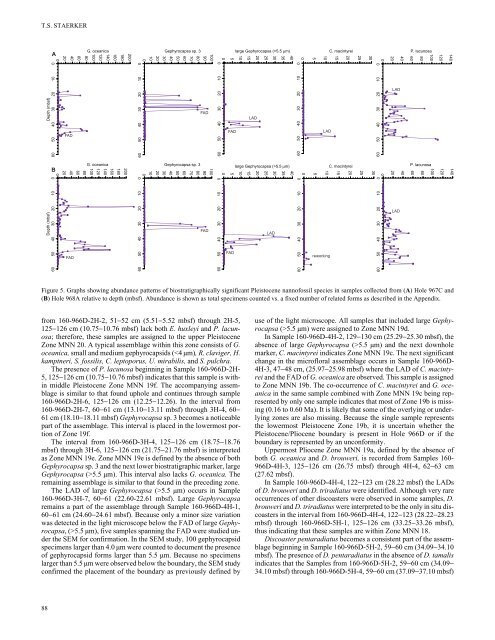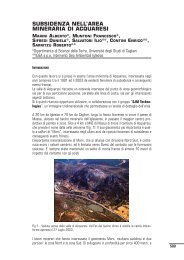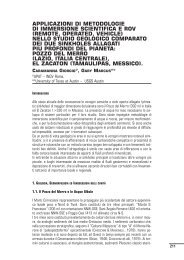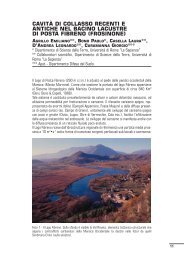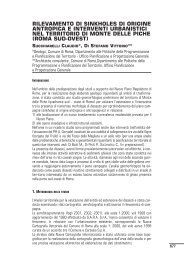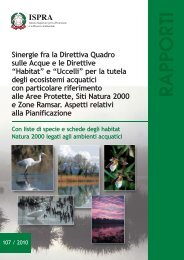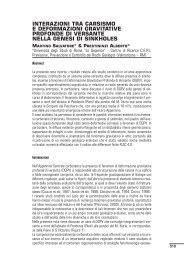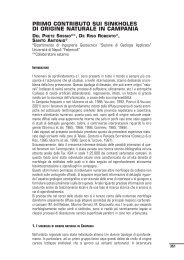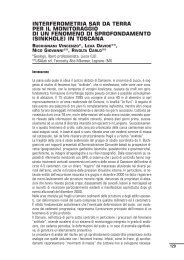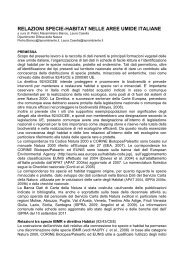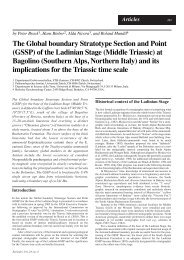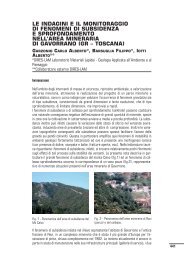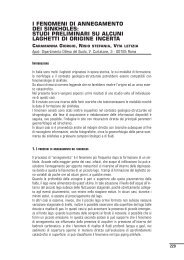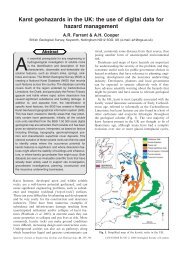7. quantitative calcareous nannofossil biostratigraphy of ... - Ispra
7. quantitative calcareous nannofossil biostratigraphy of ... - Ispra
7. quantitative calcareous nannofossil biostratigraphy of ... - Ispra
You also want an ePaper? Increase the reach of your titles
YUMPU automatically turns print PDFs into web optimized ePapers that Google loves.
T.S. STAERKER<br />
A<br />
0<br />
20<br />
40<br />
60<br />
G. oceanica Gephyrocapsa sp. 3<br />
large Gephyrocapsa (>5.5 µm)<br />
C. macintyrei<br />
P. lacunosa<br />
80<br />
100<br />
120<br />
140<br />
160<br />
180<br />
200<br />
0<br />
10<br />
20<br />
30<br />
40<br />
50<br />
60<br />
70<br />
80<br />
90<br />
100<br />
30<br />
25<br />
20<br />
15<br />
10<br />
5<br />
0<br />
40<br />
35<br />
30<br />
25<br />
20<br />
15<br />
10<br />
5<br />
0<br />
100<br />
80<br />
60<br />
40<br />
20<br />
0<br />
120<br />
140<br />
60<br />
40<br />
20<br />
Depth (mbsf)<br />
30<br />
30<br />
30<br />
30<br />
30<br />
50<br />
50<br />
10<br />
50<br />
0<br />
0<br />
20<br />
40<br />
60<br />
80<br />
100<br />
120<br />
140<br />
160<br />
180<br />
200<br />
60<br />
40<br />
10<br />
0<br />
60<br />
40<br />
50<br />
20<br />
10<br />
0<br />
120<br />
100<br />
80<br />
60<br />
40<br />
20<br />
0<br />
140<br />
60<br />
40<br />
10<br />
0<br />
60<br />
40<br />
20<br />
10<br />
0<br />
25<br />
20<br />
15<br />
10<br />
5<br />
0<br />
40<br />
35<br />
30<br />
25<br />
20<br />
15<br />
10<br />
5<br />
0<br />
30<br />
60<br />
40<br />
10<br />
0<br />
60<br />
40<br />
20<br />
10<br />
0<br />
0<br />
10<br />
20<br />
30<br />
40<br />
50<br />
60<br />
70<br />
80<br />
90<br />
100<br />
Depth (mbsf)<br />
30 20<br />
60<br />
50<br />
60<br />
40<br />
20<br />
20<br />
30<br />
40<br />
10<br />
10<br />
30<br />
0<br />
0<br />
50<br />
60<br />
50<br />
40<br />
20<br />
10<br />
0<br />
LAD<br />
FAD<br />
LAD<br />
FAD<br />
20<br />
30<br />
50<br />
FAD<br />
50<br />
LAD<br />
B<br />
20<br />
G. oceanica Gephyrocapsa sp. 3<br />
large Gephyrocapsa (>5.5 µm)<br />
C. macintyrei<br />
P. lacunosa<br />
30<br />
50<br />
FAD<br />
LAD<br />
LAD<br />
FAD<br />
FAD<br />
reworking<br />
Figure 5. Graphs showing abundance patterns <strong>of</strong> biostratigraphically significant Pleistocene <strong>nann<strong>of</strong>ossil</strong> species in samples collected from (A) Hole 967C and<br />
(B) Hole 968A relative to depth (mbsf). Abundance is shown as total specimens counted vs. a fixed number <strong>of</strong> related forms as described in the Appendix.<br />
from 160-966D-2H-2, 51−52 cm (5.51−5.52 mbsf) through 2H-5,<br />
125−126 cm (10.75−10.76 mbsf) lack both E. huxleyi and P. lacunosa;<br />
therefore, these samples are assigned to the upper Pleistocene<br />
Zone MNN 20. A typical assemblage within this zone consists <strong>of</strong> G.<br />
oceanica, small and medium gephyrocapsids (5.5 µm). This interval also lacks G. oceanica. The<br />
remaining assemblage is similar to that found in the preceding zone.<br />
The LAD <strong>of</strong> large Gephyrocapsa (>5.5 µm) occurs in Sample<br />
160-966D-3H-7, 60−61 (22.60-22.61 mbsf). Large Gephyrocapsa<br />
remains a part <strong>of</strong> the assemblage through Sample 160-966D-4H-1,<br />
60−61 cm (24.60−24.61 mbsf). Because only a minor size variation<br />
was detected in the light microscope below the FAD <strong>of</strong> large Gephyrocapsa,<br />
(>5.5 µm), five samples spanning the FAD were studied under<br />
the SEM for confirmation. In the SEM study, 100 gephyrocapsid<br />
specimens larger than 4.0 µm were counted to document the presence<br />
<strong>of</strong> gephyrocapsid forms larger than 5.5 µm. Because no specimens<br />
larger than 5.5 µm were observed below the boundary, the SEM study<br />
confirmed the placement <strong>of</strong> the boundary as previously defined by<br />
use <strong>of</strong> the light microscope. All samples that included large Gephyrocapsa<br />
(>5.5 µm) were assigned to Zone MNN 19d.<br />
In Sample 160-966D-4H-2, 129−130 cm (25.29−25.30 mbsf), the<br />
absence <strong>of</strong> large Gephyrocapsa (>5.5 µm) and the next downhole<br />
marker, C. macintyrei indicates Zone MNN 19c. The next significant<br />
change in the micr<strong>of</strong>loral assemblage occurs in Sample 160-966D-<br />
4H-3, 47−48 cm, (25.97−25.98 mbsf) where the LAD <strong>of</strong> C. macintyrei<br />
and the FAD <strong>of</strong> G. oceanica are observed. This sample is assigned<br />
to Zone MNN 19b. The co-occurrence <strong>of</strong> C. macintyrei and G. oceanica<br />
in the same sample combined with Zone MNN 19c being represented<br />
by only one sample indicates that most <strong>of</strong> Zone 19b is missing<br />
(0.16 to 0.60 Ma). It is likely that some <strong>of</strong> the overlying or underlying<br />
zones are also missing. Because the single sample represents<br />
the lowermost Pleistocene Zone 19b, it is uncertain whether the<br />
Pleistocene/Pliocene boundary is present in Hole 966D or if the<br />
boundary is represented by an unconformity.<br />
Uppermost Pliocene Zone MNN 19a, defined by the absence <strong>of</strong><br />
both G. oceanica and D. brouweri, is recorded from Samples 160-<br />
966D-4H-3, 125−126 cm (26.75 mbsf) through 4H-4, 62−63 cm<br />
(2<strong>7.</strong>62 mbsf).<br />
In Sample 160-966D-4H-4, 122−123 cm (28.22 mbsf) the LADs<br />
<strong>of</strong> D. brouweri and D. triradiatus were identified. Although very rare<br />
occurrences <strong>of</strong> other discoasters were observed in some samples, D.<br />
brouweri and D. triradiatus were interpreted to be the only in situ discoasters<br />
in the interval from 160-966D-4H-4, 122−123 (28.22−28.23<br />
mbsf) through 160-966D-5H-1, 125−126 cm (33.25−33.26 mbsf),<br />
thus indicating that these samples are within Zone MNN 18.<br />
Discoaster pentaradiatus becomes a consistent part <strong>of</strong> the assemblage<br />
beginning in Sample 160-966D-5H-2, 59−60 cm (34.09−34.10<br />
mbsf). The presence <strong>of</strong> D. pentaradiatus in the absence <strong>of</strong> D. tamalis<br />
indicates that the Samples from 160-966D-5H-2, 59−60 cm (34.09−<br />
34.10 mbsf) through 160-966D-5H-4, 59−60 cm (3<strong>7.</strong>09−3<strong>7.</strong>10 mbsf)<br />
88


